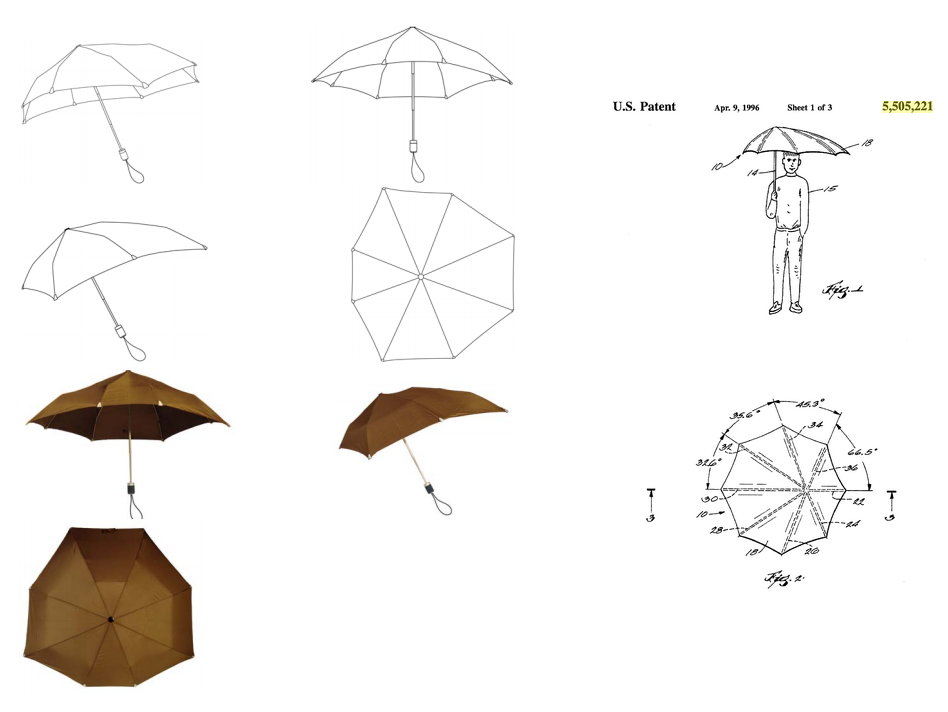Designers op zoek naar prior art kunnen het Amerikaanse octrooiregister raadplegen
OHIM Derde Kamer van Beroep 26 september 2012, R 2459/2010-3 en R 2453/2010-3 (Senz Technologies B.V. tegen Impliva B.V.; "paraplu")
 Met korte samenvatting van Laurens Kamp, Simmons & Simmons.
Met korte samenvatting van Laurens Kamp, Simmons & Simmons.
Gemeenschapsmodellenrecht. Twee identieke nietigheidsprocedures aangespannen door Impliva tegen de Gemeenschapsmodellen 579032-0001 en -0002 van Senz Technologies voor de bekende stormparaplu. De Derde Kamer van Beroep oordeelt dat het door Impliva ingeroepen oudere Amerikaanse octrooi 5,505,221 voor het publiek beschikbaar was gesteld, aangezien designers op zoek naar prior art ook het online register van het USPTO zouden kunnen raadplegen. Het Gemeenschapsmodel van Senz heeft in het licht van dit Amerikaanse octrooi geen eigen karakter en is daarom nietig.
17 The RCD proprietor has offered no convincing arguments why the Invalidity Division was wrong to hold that publication in the USPTO’s online register of a US patent would be an event which could be known to the interested circles in the EU. It has simply alleged that it is not customary for such circles to consult third country patent registers. However, this argument cannot be accepted. First, the USPTO’s register is available online and may be searched free of charge. Second, in the US designs are known as ‘design patents’ and are thus a sub-category of patents. Third, it would be imprudent for designers seeking to register designs in the EU not to check for the existence of prior art in one of the world’s major IP registers (namely, the USPTO), given the almost legendary reputation of the United States as a centre of innovation and design. Finally, the close trading relations between the United States and the European Union make it highly improbably that EU interested circles would not be aware of developments on their premier trading partner’s soil. Accordingly, the Board confirms the contested decision’s finding that the US patent was disclosed in the EU.
Overall impression of the conflicting designs 27 The question is whether the contested design and the earlier patent produce the same overall impression on the informed user, taking into consideration the designer’s degree of freedom in developing the design. 28 The Board agrees with the contested decision that the overall impression produced on the informed user is principally determined by the general appearance of the canopy, which will be marked by the shape and size rather than a multitude of technical details (see ‘Combustion Engine’ judgment, paragraph 40). Thus, the RCD proprietor’s arguments on differences between the patent and the design based on rib angle degrees, lack of point symmetry and other technical details cannot be successful. Instead the general asymmetrical ‘beak-like’ elongated appearance of the front lateral portion of the umbrellas (viz.: ) will contribute to giving both umbrellas the same overall appearance, along with the fact that both umbrellas have eight, evenly-spaced ribs, which will be visible from the underside. The close similarity of the rods and handles of the umbrellas, although they perform essentially technical functions, will not detract from the overall impression of similarity. 29 To the extent that the umbrellas may be viewed from the top, they are not significantly different: Indeed, the top views show the similar rib distribution that will be visible from underneath and the similar canopy proportions or spacing. The precise curves of the ribs of each umbrella may also be less apparent to the informed user, when viewed from underneath or from the side. In any event, the RCD proprietor does not deny that the rib angles and curvatures are designed to withstand strong winds. Differences between the umbrellas therefore also depend on aerodynamic considerations rather than pure aesthetic design. They should therefore not be given undue weight in the overall impression on the informed user. Similarly, the eye savers of the RCD are first and foremost safety features. To summarize: for these types of product designs, an informed user will be guided by basic structures alone and not by differences in the details, which do not produce different overall impressions on him (see ‘Combustion Engine’ judgment, cited above, paragraph 40). This is true despite the relatively high degree of attention of the informed user when using the product and the reasonable degree of design freedom. The basic structures of this rather unusual type of umbrella give substantially the same overall impression.





















































































